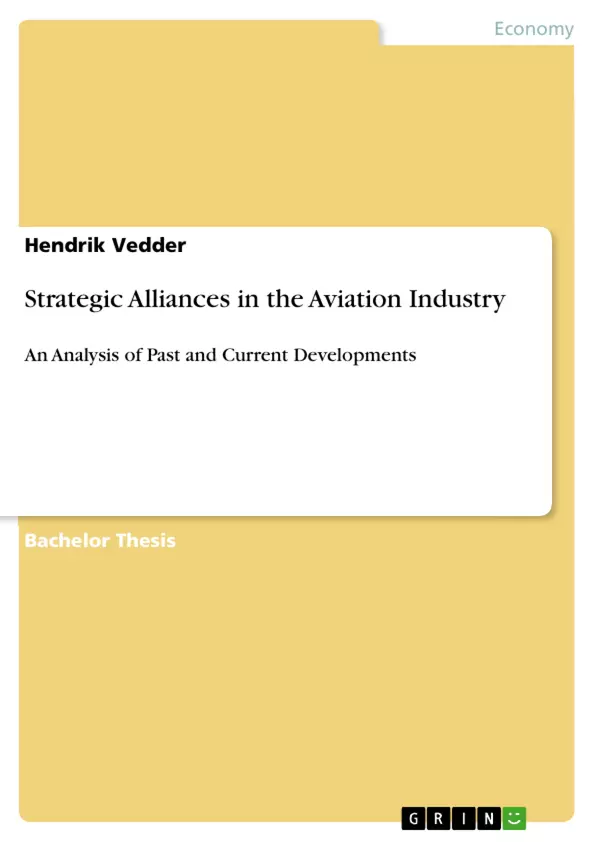“Companies are just beginning to learn what nations have always known: in a complex, uncertain world filled with dangerous opponents, it is best not to go it alone” (Ohmae, 1989, p. 143). This statement emphasises the significant developments in firms’ corporate strategy in the 1980s. As a response to the rise of globalisation, and thus, increased competition, companies throughout the world started collaborating with partners with interfirm cooperation. Their cooperative practices, though, were not equally relevant in all branches, but concentrated mainly on industries that were affected most by the in-creasing environmental dynamic and complexity. Therefore, firms in various industries, such as the automotive or telecommunication industry, established alliances with their competitors in order to stay competitive and to jointly expand into world markets. However, the aviation industry, in particular, has experienced downright alliance frenzy since that time. With the gradual liberalisation of international air transport, collabora-tions between carriers have steadily gained importance. Therefore, airline alliances have developed from purely horizontal links into more complex and integrated strategic alliances. These strategic alliances have been established mainly to bypass existing regula-tory restrictions and to adapt to customers' altered preferences by extending the airlines’ networks. However, with the incidents that occurred during the first years of the 21st century, such as the terrorist acts of 9/11, partner airlines were forced to react to the changed external conditions. This development highlights the high dependence of air-lines and their strategic behaviour on the external environment. Therefore, this thesis aims to analyse the external conditions that persuaded the airlines to align in complex strategic alliances, and how these factors influenced their objectives. Furthermore, the thesis reveals the extent to which the changes in the external environ-ment have induced a reorientation in the airlines’ alliance strategy.
Inhaltsverzeichnis (Table of Contents)
- Introduction
- Development of the Aviation Industry
- Characteristics of the Airline Business
- Historical Development of the Airline Industry
- The Phase of Regulation
- Domestic Deregulation and Liberalised Markets
- Period of Crises and Growing Low-Fare Competition
- Current Status of the Airline Industry
- The Way to a Trans-Atlantic Common Aviation Area
- Emergence of Strategic Alliances in the Airline Industry
- Inter-firm Cooperation and Strategic Alliances
- Strategic Alliances as a Special Form of Cooperation
- Attributes of Inter-firm Cooperation
- Specific Characteristics of Strategic Alliances
- Classification of Strategic Alliances
- Airline Alliances: Background Information
- Marketing versus Strategic Airline Alliances
- Areas of Cooperation in Airlines Alliances
- From Interline Agreements to Global Airline Alliances
- Motivation for Strategic Alliances Formation between Airlines
- Analysis of the External Environment in the mid-1990s
- Motives and Objectives of Strategic Airline Alliances
- Current Developments of Strategic Airline Alliances
- Strategic Alliances between Airlines in the 21st Century
- Analysis of the Current External Environment
- Change of Focus of Strategic Airline Alliances
- The Key Question - To Join or not to Join Strategic Alliances?
- Motives for Joining - The Case of Turkish Airlines
- Motives for not Joining - The Case of Emirates Airlines
- Alliances versus Mergers - The Question for the Future
Zielsetzung und Themenschwerpunkte (Objectives and Key Themes)
This thesis analyzes past and current developments of strategic alliances in the aviation industry. It aims to understand the motivations behind these alliances and their evolution over time, considering both internal and external factors influencing their formation and success.
- Historical development of the airline industry and its regulatory frameworks.
- The emergence and different types of strategic alliances within the aviation sector.
- The key motivations and objectives driving airlines to form strategic alliances.
- Analysis of the external environment influencing strategic alliance formation.
- A comparison of successful and unsuccessful strategic alliance models.
Zusammenfassung der Kapitel (Chapter Summaries)
The introduction defines the research problem and outlines the objectives of the study. The following chapters trace the historical development of the aviation industry, highlighting key regulatory changes and periods of crisis. A substantial portion focuses on the nature and types of strategic alliances, including their classification and the motivations behind their formation. Analysis of the external environment in the mid-1990s and the 21st century provides context for the strategic decisions made by airlines regarding alliances. Case studies of Turkish Airlines and Emirates Airlines illustrate different approaches to strategic alliance participation.
Schlüsselwörter (Keywords)
Strategic alliances, aviation industry, airline alliances, deregulation, globalization, competition, low-cost carriers, market analysis, external environment, case studies, Turkish Airlines, Emirates Airlines.
- Citation du texte
- Hendrik Vedder (Auteur), 2008, Strategic Alliances in the Aviation Industry, Munich, GRIN Verlag, https://www.grin.com/document/119312



